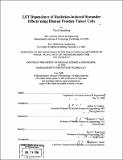| dc.contributor.advisor | Jeffrey A. Coderre. | en_US |
| dc.contributor.author | Anzenberg, Vered | en_US |
| dc.contributor.other | Massachusetts Institute of Technology. Dept. of Nuclear Science and Engineering. | en_US |
| dc.date.accessioned | 2009-03-16T19:44:08Z | |
| dc.date.available | 2009-03-16T19:44:08Z | |
| dc.date.issued | 2008 | en_US |
| dc.identifier.uri | http://hdl.handle.net/1721.1/44795 | |
| dc.description | Thesis (Ph. D.)--Massachusetts Institute of Technology, Dept. of Nuclear Science and Engineering, 2008. | en_US |
| dc.description | "June 2008." | en_US |
| dc.description | Includes bibliographical references (leaves 133-140). | en_US |
| dc.description.abstract | In the past fifteen years, evidence provided by many independent research groups have indicated higher numbers of cells exhibiting damage than expected based on the number of cells traversed by the radiation. This phenomenon has been coined as the "bystander effect". The purpose of this study was to characterize the ability of irradiated tumor cells to induce bystander effects in co-cultured cells. Human DU-145 prostate carcinoma cells were grown on a 1.4 [mu]m-thick mylar membrane in specially constructed cell culture dishes for irradiation with alpha particles (average energy 3.14 MeV) from a 241Am source, or in 6-well plates for irradiation with 250 kVp x-rays at 25°C. In parallel experiments, the tumor cells were incubated at 4°C for one hour prior to irradiation and irradiated on ice to test the nature of the bystander signal. Bystander cells were placed into the medium above the irradiated DU-145 and were co-incubated for a length of time. The bystander effect endpoints measured in either DU-145 tumor cells or in normal primary AGO1522 fibroblasts were micronucleus (MN) formation, [gamma]-H2AX double strand break repair foci, and survival fraction. A 1.5-2.0-fold increase in MN formation was observed in both DU-145 and AG01522 bystander cells after either alpha particle or xray irradiation of the DU-145 target cells. A 1.5-fold [gamma]-H2AX bystander increase and a survival fraction reduction to 80% were only detected in AGO1522 cells, and only after xray irradiation of target DU-145 cells. Alpha particle irradiation of the target DU-145 cells produced neither [gamma]-H2AX foci nor survival fraction bystander effect in either cell line. Lowering the temperature to 4°C during the irradiation of the DU-145 tumor cells, with either x-rays or alpha particles, eliminated both the MN formation and the decreased survival fraction bystander effects in the co-cultured AG01522 fibroblasts. | en_US |
| dc.description.abstract | (cont.) This study demonstrates that biochemical processes in the directly-irradiated tumor cells are required for initiation of the signaling process. Low temperature during the irradiation inhibited the initiation of a bystander signal. There are also LET-dependent differences in the signal released from DU-145 human prostate carcinoma cells; and that, for some endpoints, bystander AG01522 fibroblasts and bystander DU-145 prostate carcinoma cells respond differently to the same, medium-mediated signal. | en_US |
| dc.description.statementofresponsibility | by Vered Anzenberg. | en_US |
| dc.format.extent | 140 leaves | en_US |
| dc.language.iso | eng | en_US |
| dc.publisher | Massachusetts Institute of Technology | en_US |
| dc.rights | M.I.T. theses are protected by
copyright. They may be viewed from this source for any purpose, but
reproduction or distribution in any format is prohibited without written
permission. See provided URL for inquiries about permission. | en_US |
| dc.rights.uri | http://dspace.mit.edu/handle/1721.1/7582 | en_US |
| dc.subject | Nuclear Science and Engineering. | en_US |
| dc.subject.lcsh | Linear energy transfer | en_US |
| dc.title | LET dependence of radiation-induced bystander effects using human prostate tumor cells | en_US |
| dc.title.alternative | Linear energy transfer dependence of radiation-induced bystander effects using human prostate tumor cells | en_US |
| dc.type | Thesis | en_US |
| dc.description.degree | Ph.D. | en_US |
| dc.contributor.department | Massachusetts Institute of Technology. Department of Nuclear Science and Engineering | |
| dc.identifier.oclc | 300314347 | en_US |

